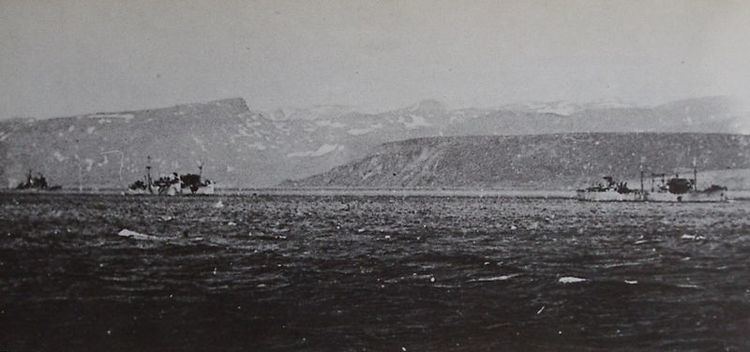The 5th Fleet (第五艦隊, Dai-go Kantai) was a fleet of the Imperial Japanese Navy, active during the early portions of the Second Sino-Japanese War, and again in World War II, primarily in the Aleutian campaign, during which it was augmented and designated the Northern Area Force.
The 5th Fleet was initially formed on 1 February 1938 as part of the Japanese military emergency expansion program in the aftermath of the North China Incident of 1937. The initial plan was to construct 3rd, 4th and 5th China Area Fleets to cover the invasions of Japanese troops into the Chinese mainland, and to interdict and control commerce on the coasts. The 4th and 5th Fleets came under the operational control of the 2nd China Expeditionary Fleet. It participated in the Hainan Island Operation and other maritime interdiction operations off the Chinese coast. The fleet was disbanded on 15 November 1939 when its operations were merged into the China Area Fleet.
The 5th Fleet was resurrected on 25 July 1941, and tasked with patrols of northern Japanese waters from the northern portion of Honshū, through Hokkaidō, the Chishima Islands, and as far as the Bonin Islands to the east. With the threat of maritime invasion by the Soviet Union considered extremely remote, and with Japanese forces focused on attacking south (Nanshin-ron), the IJN 5th Fleet was considered of secondary importance and was only assigned a couple of light cruisers and smaller vessels.
With the outbreak of World War II, and the Doolittle raid on Tokyo, the 5th Fleet was reinforced by a large number of converted armed merchant vessels. The operational plan for the Battle of Midway called for a diversionary strike north towards the Aleutian Islands. The cruisers of the 5th Fleet – designated the "Northern Area Force" after its augmentation for the operation – covered the landings of Japanese troops on Attu and Kiska on 6–7 June 1942, and were in the Battle of the Komandorski Islands against the United States Navy on 27 March 1943.
However, the IJN 5th Fleet was unable to prevent the recapture of Attu by American forces in May 1943, and &ndahs; after the abolition of the Northern Area Force on 4–5 August 1943 – from 5 August 1943 to 5 December 1944, the 5th Fleet was reorganized under the operational control of the Northeast Area Fleet, which oversaw the withdrawal of Japanese forces from Kiska and reinforcement of the northern approaches to Japan.
Following Japan's withdrawal from the Aleutians, the Northeast Area Fleet was reassigned directly to the Philippines in October 1944. It participated in the Battle of Leyte Gulf, and surviving vessels were joined to the Southeast Area Fleet on 15 December 1944. On 5 February 1945, the Southeast Area Fleet became the IJN 10th Area Fleet, at which time the remnants of the 5th Fleet's administrative structure were disbanded.
Cruiser Division 9Heavy cruiser Myōko (Flagship), Light cruiser NagaraCruiser Division 10Light cruiser Tenryū, TatsutaTorpedo Squadron 5Light cruiser YūbariDestroyer Division 3Destroyer Shiokaze, Yūkaze, Tachikaze, Hokaze, Shimakaze, Yakaze, NadakazeDestroyer Division 16Destroyer Asagao, Yūgao, Fuyō, KarukayaDestroyer Division 23Destroyer Kikuzuki, Mikazuki, Mochizuki, YūzukiCarrier Division 3Seaplane tender Kamoi, Auxiliary seaplane tender Kagu Maru, Kamikawa MaruCarrier Division 4Seaplane tender Notoro, Auxiliary seaplane tender Kinugasa MaruCruiser Division 21 (Based at Ōminato)Light cruiser Tama (Flagship), Kiso, Auxiliary seaplane tender Kimikawa Maru (based at Horomushiro)Cruiser Division 22 (based at Kushiro)Auxiliary cruiser Akagi Maru, Asaka Maru, Awata MaruGunboat Division 10Auxiliary gunboat Yoshida Maru, Magane MaruSubchaser Division 66Auxiliary subchaser Fumi Maru, No.2 Seki Maru, Auxiliary netlayer Kōgi MaruMinesweeper Division 17Auxiliary minesweeper No.5 Toshi Maru, No.8 Toshi Maru, Keinan Maru, No.10 Misago MaruPatrol division 7Support craft Hokuyō-Gō, Auxiliary support craft No.1 Sasayama Maru1st PlatoonAuxiliary patrol boat No.5 Fukuichi Maru, Chōkai Maru, No.5 Seiju Maru, Kairyū Maru2nd PlatoonAuxiliary patrol boat No.3 Yachiyo Maru, No.23 Toku Maru, No.1 Fuku Maru3rd PlatoonAuxiliary patrol boat Eikichi Maru, No.3 Shōsei Maru, Shōei Maru, No.2 Taihei Maru4th PlatoonAuxiliary patrol boat No.5 Ebisu Maru, No.2 Kaihō Maru, Kaijin Maru5th PlatoonAuxiliary patrol boat No.1 Nittō Maru, No.2 Nittō Maru, No.23 Nittō Maru6th PlatoonAuxiliary patrol boat No.25 Nittō Maru, Kōki Maru, Fuji MaruNo.7 Base Force (based at Chichi-jima)Chichijima Naval Air GroupDirect control from headquarter of the fleetTorpedo boat Sagi, HatoAttached ships for the fleetOiler ShiriyaAuxiliary gunboat Kaihō MaruAuxiliary transport ship Nissan Maru, Chōkō Maru, No.2 Tōkō Maru, Akashisan MaruCruiser Division 21 (based at Horomushiro)Heavy cruiser Nachi (Flagship), Maya, Light cruiser Tama, KisoCruiser Division 22Auxiliary cruiser Akagi Maru, Asaka Maru, Awata MaruCruiser Destroyer Squadron 1 (based at Horomushiro)Light cruiser AbukumaDestroyer Division 2 (This division was rented from CruDesron 4.)Destroyer SamidareDestroyer Division 6 (This division was rented from CruDesron 11.)Destroyer HibikiDestroyer Division 9Destroyer Asagumo, UsugumoDestroyer Division 10 (This division was rented from CruDesron 10.)Destroyer Yūgumo, Akigumo, KazagumoDestroyer Division 21 (Shimakaze was rented from CruDesron 2.)Destroyer Shimakaze, Wakaba, HatsushimoDestroyer Division 31 (This division was rented from CruDesron 2.)Destroyer NaganamiNo.51 Special Base Force (based at Kiska)Attached ships for the fleetSubmarine Flotilla 7Submarine I-2, I-4, I-5, I-6Escort ship KunashiriAuxiliary seaplane tender Kimikawa MaruAuxiliary oiler Nippon Maru, Teiyō MaruCruiser Division 16 (They did not participate in the naval battle, because it was commanded to do transportation duty.)Heavy cruiser Aoba, Light cruiser Kitakami, Kinu, Destroyer UranamiCruiser Division 21Heavy cruiser Nachi (Flagship), AshigaraLight cruiser Tama (She was lent to the 3rd Fleet.)Light cruiser Kiso (She did not participate in the naval battle, because it was commanded to do transportation duty.)Cruiser Destroyer Squadron 1Light cruiser AbukumaDestroyer Division 7Destroyer Akebono, UshioDestroyer Division 18Destroyer Shiranui, KasumiDestroyer Division 21 (It did not participate in the naval battle, because it was commanded to do transportation duty.)Destroyer Hatsuharu, Wakaba, HatsushimoHeavy cruiser Ashigara (Flagship)Cruiser Destroyer Squadron 31Light cruiser IsuzuDestroyer Division 43Destroyer Take, Ume, Momo, Sugi, Maki, KaedeDestroyer Division 52Destroyer Kashi, HinokiCoast Defence Division 21Escort ship Manju, Kanju, Kasado, Miyake, Ikuna, Yaku933rd Naval Air Group (Based at Saiki)Attached ships for fleetEscort ship No.21, No.22, No.29, No.31, No.43Commanders of the IJN 5th Fleet
Commander in chief
Chief of Staff

